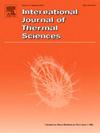Compact integrated electromagnetic driving of liquid metal for high heat-flux dissipation
IF 4.9
2区 工程技术
Q1 ENGINEERING, MECHANICAL
International Journal of Thermal Sciences
Pub Date : 2025-01-26
DOI:10.1016/j.ijthermalsci.2025.109725
引用次数: 0
Abstract
Liquid metal (LM) has been widely utilized in scenarios involving overloaded thermal energy delivery and high heat flux thermal management due to its excellent thermal properties. However, the high-performance driving method limits LM-based thermal management. In this paper, a compact integrated rotating permanent magnet induction electromagnetic pump (PM-EMP) is developed for LM. In addition, a three-dimensional multi-physical field numerical method and accurate analytical prediction correlation are built to optimize PM-EMP performance. We systematically investigate the magnetohydrodynamic generation process and factors influencing performance. The results demonstrate that optimizing electromagnetic parameters significantly weakens non-sinusoidal distribution, thereby promoting high output characteristics and flow stability in PM-EMP. By binding the tangential component within the short-circuit strip, we enhance and uniformly distribute the vertical component of current density along channel width, improving current density by 110 %. This optimization facilitates near-wall current distribution to suppress lateral end effects. Notably, strengthening magnetic flux and current density distribution/intensity reduces local pressure pulsation, thus enhancing driving characteristics and flow stability. Considering the influence of lateral end effect and geometric parameters, the performance prediction accuracy obtained by modified analytical correlation can achieve more than 90 % improvement by 28.9 %. Furthermore, we validate the effectiveness of theoretical methods by prototype performance testing.
求助全文
约1分钟内获得全文
求助全文
来源期刊

International Journal of Thermal Sciences
工程技术-工程:机械
CiteScore
8.10
自引率
11.10%
发文量
531
审稿时长
55 days
期刊介绍:
The International Journal of Thermal Sciences is a journal devoted to the publication of fundamental studies on the physics of transfer processes in general, with an emphasis on thermal aspects and also applied research on various processes, energy systems and the environment. Articles are published in English and French, and are subject to peer review.
The fundamental subjects considered within the scope of the journal are:
* Heat and relevant mass transfer at all scales (nano, micro and macro) and in all types of material (heterogeneous, composites, biological,...) and fluid flow
* Forced, natural or mixed convection in reactive or non-reactive media
* Single or multi–phase fluid flow with or without phase change
* Near–and far–field radiative heat transfer
* Combined modes of heat transfer in complex systems (for example, plasmas, biological, geological,...)
* Multiscale modelling
The applied research topics include:
* Heat exchangers, heat pipes, cooling processes
* Transport phenomena taking place in industrial processes (chemical, food and agricultural, metallurgical, space and aeronautical, automobile industries)
* Nano–and micro–technology for energy, space, biosystems and devices
* Heat transport analysis in advanced systems
* Impact of energy–related processes on environment, and emerging energy systems
The study of thermophysical properties of materials and fluids, thermal measurement techniques, inverse methods, and the developments of experimental methods are within the scope of the International Journal of Thermal Sciences which also covers the modelling, and numerical methods applied to thermal transfer.
 求助内容:
求助内容: 应助结果提醒方式:
应助结果提醒方式:


